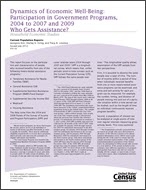Dynamics of Economic Well-Being: Participation in Government Programs, 2004 to 2007 and 2009 Who Gets Assistance?
Dynamics of Economic Well-Being: Participation in Government Programs, 2004 to 2007 and 2009 Who Gets Assistance?
This report focuses on the participation and characteristics of people who received benefits from any of the following means-tested assistance programs:1
- Temporary Assistance for Needy Families (TANF)
- General Assistance (GA)
- Supplemental Nutrition Assistance Program (SNAP)/Food Stamps2
- Supplemental Security Income (SSI)
- Medicaid3
- Housing Assistance
The data come from the 2004 and 2008 Panels of the Survey of Income and Program Participation (SIPP) and cover calendar years 2004 through 2007 and 2009.4 SIPP is a longitudinal survey, which means that, unlike periodic point-in-time surveys such as the Current Population Survey (CPS), SIPP follows the same people over time.5 This longitudinal quality allows examination of the SIPP sample from two perspectives.
First, it is possible to observe the same people over a span of time. The number of months within a period of time when individuals received benefits from one or more means-tested assistance programs can be examined, and entry and exit activity for each program can be measured. For example, the number, timing, and duration of people moving into and out of a particular situation within a time period can be studied, such as the length of time an individual continuously receives program benefits.
Second, a population of interest can be analyzed at single points of time over regular intervals measuring gross activity levels. This cross-sectional perspective captures changes over time in the level of an activity, such as the proportion of the population receiving assistance from a particular program at selected points in time.
This report examines means-tested program participation rates and the extent to which the programs are used. Appendix A displays the average monthly participation rates in major means-tested programs by selected characteristics.
_______________
1 Means-tested programs are those that require the income and/or assets of an individual or family to fall below specified thresholds in order to qualify for benefits. There may be additional eligibility requirements to receive these programs, which provide cash and noncash assistance to eligible individuals and families.
2 The Food Stamp Program was renamed the Supplemental Nutrition Assistance Program (SNAP) in 2008.
3 This program, which in SIPP includes the State Children’s Health Insurance Program (SCHIP), is different from Medicare, which provides health insurance coverage to people 65 years and older, to people under 65 with certain disabilities, and to people of any age with end stage renal disease.
4 The 2004 Panel followed the same individuals over a period of 48 months from October 2003 to December 2007, and the 2008 Panel is currently scheduled to follow the same individuals over a period of 68 months from May 2008 to March 2014. The data in this report were collected from February 2004 through January 2008 in all 12 waves of the 2004 SIPP and from February 2009 through April 2010 in waves 2–5 of the 2008 SIPP. The population represented (the population universe) is the civilian, noninstitutionalized population living in the United States. The sample of households in SIPP is divided into four interview groups, called rotation groups. Each month, one of the four rotation groups is interviewed about the previous four months (the reference period). For individuals interviewed in rotations 1, 2, and 3 of the 2004 SIPP, monthly data were not collected for all months at the end of 2007. Data are available for January 2004 through September 2007 for individuals interviewed in the first rotation group, for January 2004 through October 2007 for individuals interviewed in the second rotation group, and for January 2004 through November 2009 for individuals interviewed in the third rotation group. Only those individuals interviewed in the fourth rotation group of the 2004 SIPP have data for January 2004 through December 2007. In the 2008 SIPP, all rotation groups have data for January 2009 through December 2009. For more detail on the interview procedures, interview waves, or rotation groups, see Chapter 2 of the SIPP User’s Guide at <www.census.gov/sipp/usrguide/ch2_nov20.pdf>.
5 The longitudinal estimates presented here are based on people who were interviewed in all waves of the reference period or for whom imputed information exists. Efforts were made during the life of the panel to ensure that the sample remained representative of the civilian, noninstitutionalized population of the United States by attempting to follow people who moved to a new address. If the people included in the estimates have different experiences in program participation than those who did not respond initially, left the sample, or missed two or more consecutive waves, these longitudinal estimates may be biased.
Others in Series
Publication
Publication
Publication




